Overarching Aims, Duties and Principles
Scope of this chapter
Safeguarding is 'protecting an adult's right to live in safety, free from abuse and neglect'.
In order to safeguard the people we support, we all need to understand our responsibilities and what is expected of us by law.
This chapter explains the overarching aims, duties and principles of all adult safeguarding.
Overarching: always applies
Aims: The purpose of safeguarding - what we should be trying to achieve
Duties: Legal responsibilities - the things we must do
Principles: Ways of working - to guide what we do and how we do it
Relevant Regulations
Related Chapters and Guidance
The aims of adult safeguarding are set out in the statutory guidance accompanying the Care Act 2014. Everyone must legally do their best to achieve these aims - this includes services like ours, the police, the NHS and the local authority.
The aims are both reactive and proactive:
Reactive: When an adult is experiencing abuse or neglect
Proactive: To reduce the risk of abuse ever happening
- To prevent harm and reduce the risk of abuse or neglect to the person with care and support needs;
- To stop abuse or neglect whenever possible;
- To safeguard the person in a way that supports them to make choices and have control around the way they want to live;
- To promote an approach that concentrates on improving life for the person or persons concerned;
- To raise public awareness so that communities as a whole, alongside professionals, play their part in preventing, identifying and responding to abuse and neglect;
- To provide information and support in accessible ways, to help people understand the different types of abuse, how to stay safe and well, and what to do to raise a concern about the safety or wellbeing of themselves or another adult; and
- To address what has caused the abuse or neglect.
The Care Quality Commission and any organisation commissioning our service will consider how well we are doing at achieving these aims during inspections.
The duties of adult safeguarding are set out in the Care Act 2014. They are the things that must be done by law.
The main duties are the responsibility of the local authority as they are the lead organisation for adult safeguarding.
Our main duty is to recognise abuse or neglect and report concerns when all the following applies:
The person:
- Has needs for care and support; and
- They are experiencing, or at risk of experiencing abuse or neglect; and
- As a result of their care and support needs, they are unable to protect themselves against the abuse or neglect.
We also have a duty to co-operate with any safeguarding enquiry that takes place. This includes providing the local authority with any information it requests, or that we feel will help the enquiry process.
The registered person has additional duties to meet:
- Ensure that all staff are clear about their safeguarding role and responsibilities (including bank and agency staff, volunteers and students on placement);
- Create strong multi-agency partnerships and work effectively and proactively to prevent abuse and neglect from occurring;
- Support a positive learning development culture in the service to address safeguarding issues;
- Ensure clear procedures are in place for staff to report safeguarding matters. Procedures should detail the correct telephone number/s and/or email/s and be easily accessible.
There are 3 principles for adult safeguarding:
- The six key principles of adult safeguarding;
- Making Safeguarding Personal (MSP);
- The principles of the Mental Capacity Act 2005.
The six key principles of all adult safeguarding are set out in the Care Act 2014 statutory guidance.
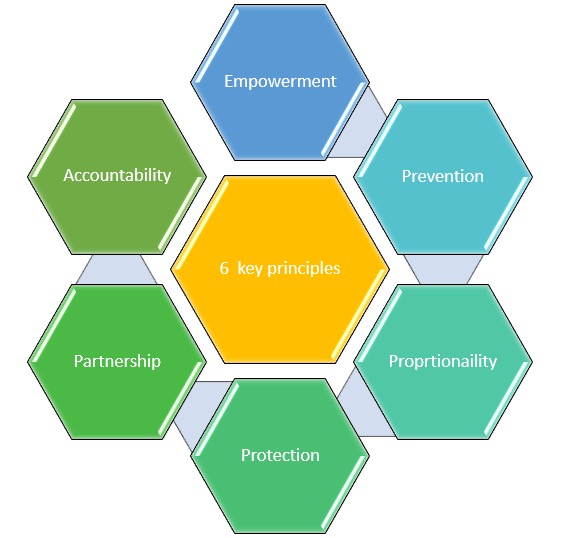
Each principle is explained below, alongside an ‘I’ statement. The ‘I’ statements explain what it would feel like in action to a person affected by safeguarding.
1. Empowerment:
- Encourage and support people to make their own decisions, including to consent
- Give people as much independence, power, choice and control as possible
- Give people good information to enable them to make an informed decision
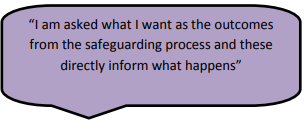
2. Prevention:
- Make sure you understand how to recognise when someone may be at risk of abuse or neglect and what to do about it
- Take action to prevent abuse or neglect occurring rather than waiting until it’s too late
- Identify risks and act before they escalate
- Make sure individual care or support plans have effective strategies to manage risks
- Learn from previous incidents and safeguarding issues
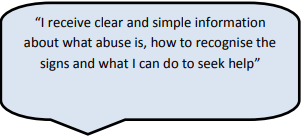
3. Proportionality:
When we are deciding what action to take it is important to consider the impact of the available options on the person. We need to prevent them from experiencing abuse or neglect, but the action that we take must be the least intrusive response possible.
Peter is supported to go to the disco held at his local pub every month. Last time he went another person approached Peter, called him an offensive name and pushed him. Peter was upset by the incident but unharmed and didn’t want his support worker to raise a safeguarding concern to the local authority.
Back in the service, Peter’s support worker talked through what had happened with their manager and completed a risk assessment to decide what action they needed to take to prevent it happening again.
The only way to prevent it happening again would be to stop supporting Peter to go to the disco. However, Peter likes the disco and has made it clear that he doesn’t want to stop going.
It is decided that the most proportionate response is to choose a table not near to the other person and not dance near the other person. It is also agreed that the support worker will speak to the pub landlord, who subsequently agrees to provide security at the disco to monitor the actions of the other person and escort them from the venue if necessary.
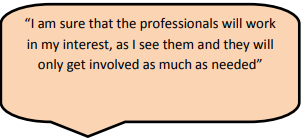
4. Protection:
Protection from harm, but also protection of rights. For example, making sure the person understands their rights and is supported to exercise them, for example to report abuse to the police. If a person has difficulty taking part in a safeguarding process, it could mean supporting them to access advocacy or another form of representation.
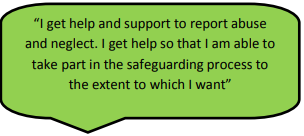
5. Partnership:
Safeguarding is everyone’s responsibility, and it is important that we work well with each other, the person’s family/friends, external agencies such as the local authority, NHS, police and local services we support people to use such as banks, shops and social venues. This will help get the best outcome for the people we support.
Partnership includes sharing information about the person with their consent, or without it if necessary and within the remit of safeguarding.
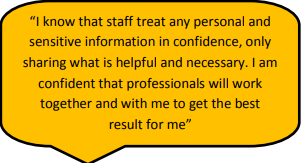
6. Accountability:
Safeguarding practice should be accountable and transparent. Everyone should be aware of the role of others, and what actions are being taken to safeguard someone. Clear records should be kept, and decisions clearly documented, along with the reasoning behind them.
The person should be consulted and involved in the process at all times, and kept informed of what is happening.
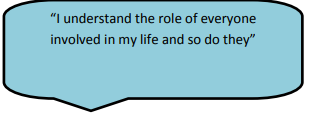
Making Safeguarding Personal (MSP) is an approach to safeguarding that is person-led and outcomes-focussed.
It is about having conversations with people about how responses to safeguarding situations can be made in a way that enhances their involvement, choice and control as well as improving their quality of life, well-being and safety.
It is about seeing people as experts in their own lives and working alongside them to identify the outcomes they want.
It focuses on achieving meaningful improvements to people's lives to prevent abuse and neglect occurring in the future, including ways for them to protect themselves and build resilience.
It recognises that people come with a variety of different preferences, histories, circumstances and life-styles; so safeguarding arrangements should not prescribe a process that must be followed whenever a concern is raised, but instead take a more personalised approach.
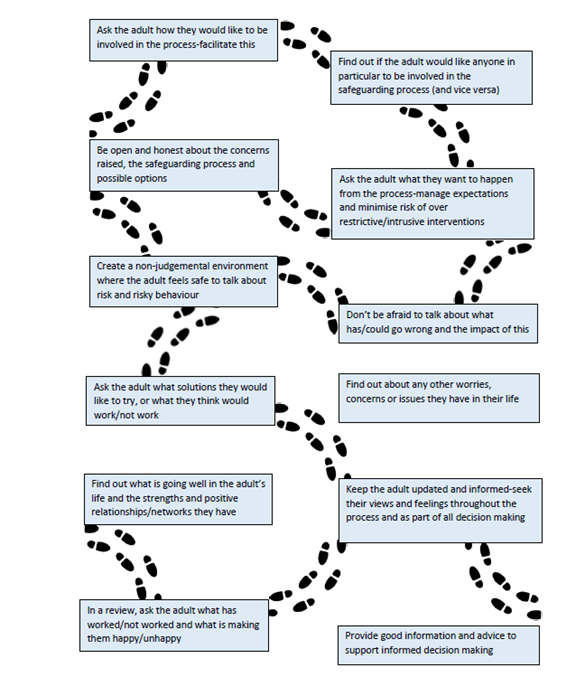
The Local Government Association (LGA) has developed a host of resources to support Making Safeguarding Personal:
Making Safeguarding Personal toolkit
Making Safeguarding Personal-audio-visual resources
Making Safeguarding Personal-Working with risk
Supporting increased involvement of service users
What might ‘good’ look like for health and social care commissioners and providers
The first three principles of the Mental Capacity Act 2005 should always be applied before making a judgement about mental capacity.
|
Principle 1 A person must be assumed to have capacity unless it is established that they lack capacity. |
Every person from the age of 16 has a right to make their own decisions if they have the capacity to do so. You must assume that a person has capacity to make a particular decision at a point in time unless it can be established that they do not. |
|
Principle 2 A person is not to be treated as unable to make a decision unless all practicable steps to help him to do so have been taken without success. |
People should be supported to help them make their own decisions. No conclusion should be made that a person lacks capacity to make a decision unless all practicable steps have been taken to try and help them make a decision for themselves. |
|
Principle 3 A person is not to be treated as unable to make a decision merely because he makes an unwise decision. |
A person who makes a decision that others think is unwise should not automatically be labelled as lacking the capacity to make a decision. |
If a person has been assessed as lacking capacity to make a decision about safeguarding, principles 4 and 5 apply.
|
Principle 4 An act done or decision made, under this Act for or on behalf of a person who lacks capacity must be done, or made, in his best interests. |
If the person lacks capacity any decision that is made on their behalf, or subsequent action taken must be done using Best Interests, as set out in the Act. |
|
Principle 5 Before the act is done, or the decision is made, regard must be had to whether the purpose for which it is needed can be as effectively achieved in a way that is less restrictive of the person's rights and freedom of action. |
As long as the decision or action remains in the person's Best Interests it should be the decision or action that places the least restriction on their basic rights and freedoms. |
See: Mental Capacity
The registered person is responsible for ensuring that the whole service understands the aims, duties and principles of adult safeguarding and how to apply them, and that they are indeed being applied.
However, each of us is personally responsible for our own actions (or inaction) and can be held to account for any personal failure to act that results in a person experiencing or continuing to experience abuse or neglect.
Last Updated: September 12, 2022
v27